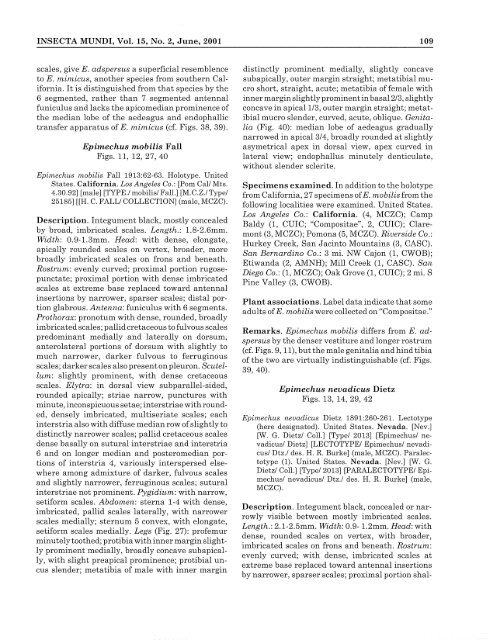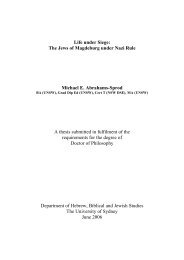Epimechus Dietz (Coleoptera: Curculionidae: Anthonomini)
Epimechus Dietz (Coleoptera: Curculionidae: Anthonomini)
Epimechus Dietz (Coleoptera: Curculionidae: Anthonomini)
Create successful ePaper yourself
Turn your PDF publications into a flip-book with our unique Google optimized e-Paper software.
INSECTA MUNDI, Vol. 15, No.2, June, 2001<br />
scales, give E. adspersus a superficial resemblence<br />
to E. mimicus, another species from southern California.<br />
It is distinguished from that species by the<br />
6 segmented, rather than 7 segmented antennal<br />
funiculus and lacks the apicomedian prominence of<br />
the median lobe of the aedeagus and endophallic<br />
transfer apparatus of E. mimicus (cf. Figs. 38, 39).<br />
<strong>Epimechus</strong> mobilis Fall<br />
Figs. 11, 12, 27, 40<br />
<strong>Epimechus</strong> mobilis Fall 1913:62-63. Holotype. United<br />
States. California. Los Angeles Co.: [Porn Call Mts.<br />
4.30.92] [male] [TYPE.! mobilis/ Fall.] [M.C.Z'/ Type/<br />
25185] [[H. C. FALL! COLLECTION] (male, MCZC).<br />
Description. Integument black, mostly concealed<br />
by broad, imbricated scales. Length.: 1.8-2.6mm.<br />
Width: 0.9-1.3mm. Head: with dense, elongate,<br />
apically rounded scales on vertex, broader, more<br />
broadly imbricated scales on frons and beneath.<br />
Rostrum: evenly curved; proximal portion rugosepunctate;<br />
proximal portion with dense imbricated<br />
scales at extreme base replaced toward antennal<br />
insertions by narrower, sparser scales; distal portion<br />
glabrous. Antenna: funiculus with 6 segments.<br />
Pro thorax: pronotum with dense, rounded, broadly<br />
imbricated scales; pallid cretaceous to fulvous scales<br />
predominant medially and laterally on dorsum,<br />
anterolateral portions of dorsum with slightly to<br />
much narrower, darker fulvous to ferruginous<br />
scales; darker scales also present on pleuron. Scutellum:<br />
slightly prominent, with dense cretaceous<br />
scales. Elytra: in dorsal view subparallel-sided,<br />
rounded apically; striae narrow, punctures with<br />
minute, inconspicuous setae; interstriae with rounded,<br />
densely imbricated, multi seriate scales; each<br />
inters tria also with diffuse median row of slightly to<br />
distinctly narrower scales; pallid cretaceous scales<br />
dense basally on sutural interstriae and inters tria<br />
6 and on longer median and posteromedian portions<br />
of interstria 4, variously interspersed elsewhere<br />
among admixture of darker, fulvous scales<br />
and slightly narrower, ferruginous scales; sutural<br />
interstriae not prominent. Pygidium: with narrow,<br />
setiform scales. Abdomen: sterna 1-4 with dense,<br />
imbricated, pallid scales laterally, with narrower<br />
scales medially; sternum 5 convex, with elongate,<br />
setiform scales medially. Legs (Fig. 27): profemur<br />
minutely toothed; protibia with inner margin slightly<br />
prominent medially, broadly concave subapically,<br />
with slight preapical prominence; protibial uncus<br />
slender; metatibia of male with inner margin<br />
109<br />
distinctly prominent medially, slightly concave<br />
subapically, outer margin straight; metatibial mucro<br />
short, straight, acute; metatibia of female with<br />
inner margin slightly prominent in basal 2/3, slightly<br />
concave in apical 1/3, outer margin straight; metatibial<br />
mucro slender, curved, acute, oblique. Genitalia<br />
(Fig. 40): median lobe of aedeagus gradually<br />
narrowed in apical 3/4, broadly rounded at slightly<br />
asymetrical apex in dorsal view, apex curved in<br />
lateral view; endophallus minutely denticulate,<br />
without slender sclerite.<br />
Specimens examined. In addition to the holotype<br />
from California, 27 specimens of E. mobilis from the<br />
following localities were examined. United States.<br />
Los Angeles Co.: California. (4, MCZC); Camp<br />
Baldy (1, CUIC; "Compositae", 2, CUIC); Claremont<br />
(3, MCZC); Pomona (5, MCZC). Riverside Co.:<br />
Hurkey Creek, San Jacinto Mountains (3, CASC).<br />
San Bernardino Co.: 3 mi. NW Cajon (1, CWOB);<br />
Etiwanda (2, AMNH); Mill Creek (1, CASC). San<br />
Diego Co.: (1, MCZC); Oak Grove (1, CUIC); 2 mi. S<br />
Pine Valley (3, CWOB).<br />
Plant associations. Label data indicate that some<br />
adults of E. mobilis were collected on "Compositae."<br />
Remarks. <strong>Epimechus</strong> mobilis differs from E. adspersus<br />
by the denser vestiture and longer rostrum<br />
(cf. Figs. 9, 11), but the male genitalia and hind tibia<br />
of the two are virtually indistinguishable (cf. Figs.<br />
39,40).<br />
<strong>Epimechus</strong> nevadicus <strong>Dietz</strong><br />
Figs. 13, 14, 29, 42<br />
<strong>Epimechus</strong> neuadicus <strong>Dietz</strong> 1891:260-261. Lectotype<br />
(here designated). United States. Nevada. [Nev.]<br />
[W. G. <strong>Dietz</strong>/ CoIl.] [Type/ 2013] [<strong>Epimechus</strong>/ nevadicus/<br />
<strong>Dietz</strong>] [LECTOTYPE/ <strong>Epimechus</strong>/ nevadicus/<br />
Dtz.! des. H. R. Burke] (male, MCZC). Paralectotype<br />
(1). United States. Nevada. [Nev.] [W. G.<br />
<strong>Dietz</strong>/ CoIl.] [Type/2013] [PARALECTOTYPE/ <strong>Epimechus</strong>/<br />
nevadicus/ Dtz./ des. H. R. Burke] (male,<br />
MCZC).<br />
Description. Integument black, concealed or narrowly<br />
visible between mostly imbricated scales.<br />
Length.: 2.I-2.5mm. Width: 0.9-1.2mm. Head: with<br />
dense, rounded scales on vertex, with broader,<br />
imbricated scales on frons and beneath. Rostrum:<br />
evenly curved; with dense, imbricated scales at<br />
extreme base replaced toward antennal insertions<br />
by narrower, sparser scales; proximal portion shal-
















